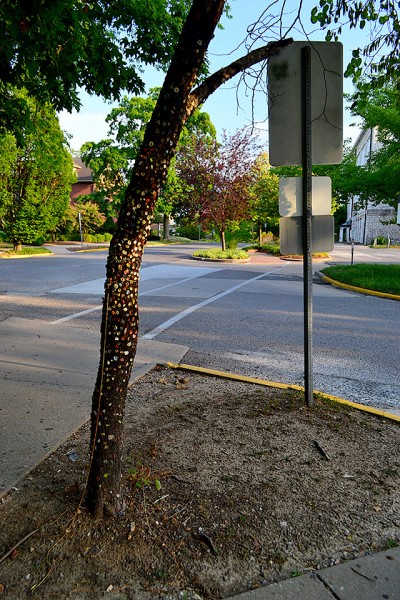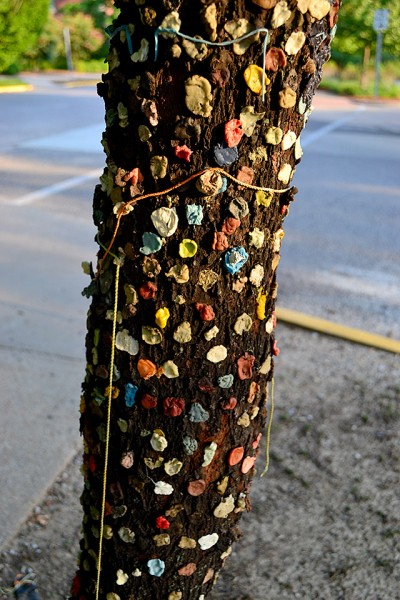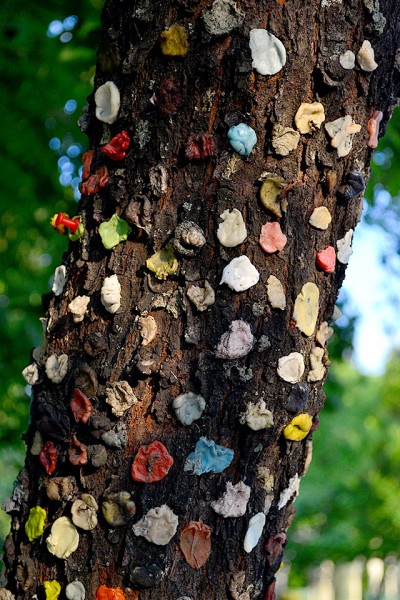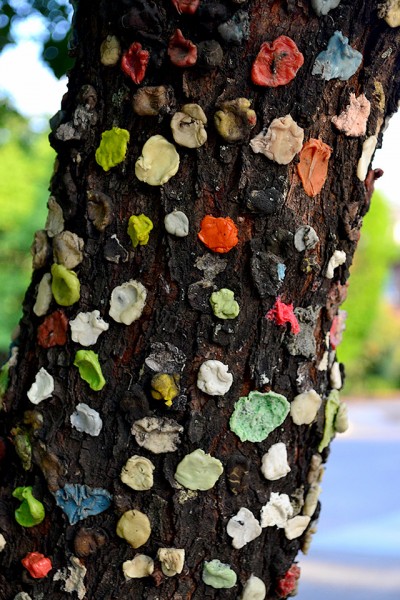At the top of SEMO’s Cardiac Hill is another campus landmark: Gum Tree Version II (at least). I call it Version II (at least) because a March 14,2002, Missourian story says that the original Gum Tree was chopped down by vandals in 1989. The tree can be found at Pacific Street and Alta Vista Drive. (Click on the photos to make them larger.)
Where was the original tree?
This isn’t the location of the Gum Tree I remember. I’m pretty sure it was in the median of front of Academic Hall, just on the west downhill side of Normal. Or, someplace close to that. I vaguely remember shooting a picture of it, but I haven’t stumbled across it yet.
I can’t claim that I ever stuck a wad on the tree. I wasn’t much of a gum chewer. I don’t know if that was the tree that was murdered in 1989. If it wasn’t, then this tree would be Version III.
Is the tree a biohazard?
I’m surprised that some loss control zealot hasn’t removed the tree as a biohazard. There’s no telling what lurks on those expelled globs.
Yes, THAT Santa Anna
Here’s an interesting factoid: “Development of Chicle Gum came with a big breakthrough in 1869… Exiled Mexican former president and general, Antonio Lopez de Santa Anna (infamous for his victory over the Alamo defenders) was living in New Jersey. He brought a ton of Mexican chicle with him, in hopes of selling it. He persuaded Thomas Adams of Staten Island, New York to buy it… Adams intended to vulcanize the chicle for use as a rubber substitute. But his efforts at vulcanization did not work. However, Adams noticed that Santa Anna liked to chew the chicle. Disappointed with the rubber experiments, Adams boiled a small batch of chicle in his kitchen to create a chewing gum. He gave some to a local store to see if people would buy it. People liked his gum, and before long his business was quite successful.”
Gum’s more fluorescent today
Our gum was pretty bland. Bubble gum might have ended up a weak pink, but your basic Spearmint and Juicy Fruit chewed down to a boring gray. This tree has some bright colors.
I was looking at a site that will sell you Old Time Candy. Here’s a sample of brands I remember:
- Bazooka Bubble Gum
- Beemans Gum
- Big Red Gum
- Black Jack Gum
- Not remembered: Bubbaloo Liquid-filled Bubble Gum
- Bubble Gum Cigars (in blue and pink) for birth announcements
- Bubble Gum Cigarettes (I don’t remember gum ones, but do recall the hard candy ones)
- Bubble Yum
- Chiclets
- Clove Gum
- Dentyne
- Doublemint
- Double Bubble
- Fruit Stripe Gum
- Juicy Fruit
- Spearmint
- Teaberry
- Trident





An that was the start of Black Jack Gum, dog gone. Reminds me of the Lifesaver story, a chocolate candy maker watched a pharmacist make pills one day and figured out how to make Lifesavers. It was after the Titanic sinking and lifesavers were big, so he put a hole in the candy…sold the formula for $2900. Wrigley’s bought for millions later.
At least with the”Gum Tree” you know where you can find a cheap chew!! I used to walk by it but it wasn’t as prominent in 1961
Ken,
I have told numerous stories about the tradition of the SEMO gum tree. With a daughter at Texas A&M, where tradition is at the supreme, this was about as cool as Dad coud get.
It was on the median as you crossed towards Leming Hall and headed for Meyers and Houck field house. Made a numbr of deposits myself during my tenure there. If I rememder they would occassionally clean it.
What a great big ball of gum that would have made.
My experience at SEMO is from 1973 on. There was a small tree (about the size of the current one) in the current location at Alta Vista and Pacific that was referred to and obvious as the gum tree; it was the one that was destroyed in 1989.
I was never much of a gum chewer, so that gum tree was of little interest. What WAS of interest to my friends and me was the HUGE (ash?) tree in front of Academic Hall. Rumor had it that you could take those long seed pods, dry them, then smoke them like cigars to get a ‘high’. Did not work (to my knowledge) but it was not for lack of our efforts!
The trees that used to be in front of Academic with the long seed pods were very old Catalpa trees.
Catalpas do live a very long time. When I worked at a historic site in SE Pennsylvania in the 1970s, the “iron master” had planted some in the garden above his mansion in the 1840s. I was sure they were about to expire and so we planted young seedlings not far from each of the originals. Both old and young were still going strong in 2008! And at the “company store”, we sold old fashioned sweets like rock candy on a string and horehound drops.
During one of my last trips home with some of my kids, I drove them to SEMO specifically to show them the gum tree and Cardiac Hill. I’m not sure if they were impressed or grossed out by the tree.
You could have REALLY impressed them by studying the tree carefully, then pulling off a wad saying, “Yep. That’s my flavor. I remember sticking it there.”
If you could have faked popping it into your mouth, that would have sealed the deal.
Now why didn’t I think of this?! Although it gives me something to do for an encore trip.
Ken (Mary here), speaking of “OLD” gum, I have a piece of Juicy Fruit from 1917; my paternal grandfather had saved it along with mementos of his time in France and Germany during WWI. It is a dull gray, as you mentioned.
Dennis and I both attend SEMO but we don’t remember the gum tree.
Chewed or unchewed?
I have no clue what made me think of the old gum tree this morning, but I googled it and read this article and saw a familiar name. Probably doesn’t remember me, but knowing I’m a TKE from the latter part of her tenure might jog the memory (probably not). 🙂
Ken, the gum is unchewed and still in the wrapper. The liquid has leached through and onto a Christmas card.
I wrote a column for the Arrow in 1989 when the first tree was assassinated.